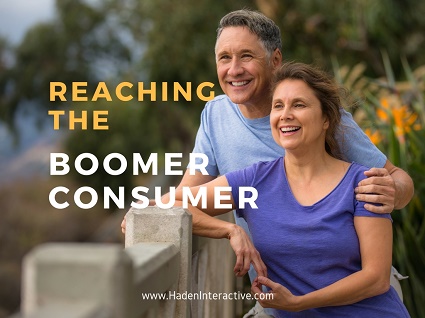Your cart is currently empty!

Reaching the Boomer Consumer
Reaching Millennials is top of mind for plenty of marketers, but some industries should also be thinking about how to reach the Boomer consumer, people born during the 1946-1964 Baby Boom. The two groups of consumers are just about the same size, at this point, and the Boomers tend to have more disposable income. In fact, while they make up about 30% of the population, they control 50% of discretionary income. With annual spending power of $2.3 trillion, they outspend other demographics by about $400 billion a year. They’re more health conscious than their Millennial offspring, too.
Baby Boomers are an underserved demographic for health and wellness marketers.
Baby Boomers are the big spenders for many health and wellness related industries:
- skin care
- hair care
- salon services
- spa services
- teeth whitening
- personal health care services
- functional foods — foods with specific health benefits
- OTC health treatments
- pharmaceuticals in general
Boomers are also keeping up their visits to the gym, and are more likely to work with personal trainers than younger visitors. Unsurprisingly, they also tend to do more healthcare spending, because they may face more healthcare needs as they grow older.
Baby Boomers tend to be less price conscious than other demographics when it comes to beauty products, and specific anti-aging ingredients can appeal to these consumers. They’re also more likely to research ingredients thoroughly, according to recent studies of HBC marketing, and they tend to think of health and wellness purchases as necessities, not luxuries.
Yet marketers are less likely to reach out to this demographic than to millennials.
Where can you find the Boomer Consumer?
This demographic spends more time online than any other age group, according to Forrester Research. They also spend more money online. But they’re less likely to go mobile than younger consumers — about two thirds prefer to use their desktop computer to research information and shop. So you can reach this group with a great desktop website experience.
Still, 86% of this population uses a smartphone, so those figures may change. And one third of the group already does consumer research on mobile devices.
You’ll find your Boomer consumers in social media, too. They’re the fastest-growing users. Since Baby Boomers tend to rely on word of mouth or recommendations from friends and family, social media is likely to be an important channel for communicating about your brand to this demographic. While friends and family recommendations are top with this demographic, though, they’re almost equally likely to go to consumer reviews, magazines, and blogs for knowledge about these issues.
How can you talk to Boomers?
Consumers in their 50s are in better health than their parents were at the same age, and they don’t think of themselves as old. In fact, recent research suggests that this group responds better to content that celebrates their healthy lifestyle than to content focusing on pain and problems.
Still, this age group is more likely to be coping with health problems than younger consumers. More than 60% of Americans in this age group have been diagnosed with a chronic disease of some kind, from high blood pressure to diabetes to acid reflux. This population is also likely to be concerned about things like thinning hair, dark spots on skin, and wrinkles.
How do female Boomers approach health and beauty concerns? They look for information. While friends and family recommendations are top with this demographic, they’re almost equally likely to go to consumer reviews, magazines, and blogs for knowledge about these issues. But once again, they tend to think in terms of health, focusing less on beauty problems than on health benefits of skin and hair care products and even cosmetics.
As for Boomer men, they are slightly more concerned with looking good to the opposite sex than women in the same age group, according to a recent survey. 69% of men in this age group want to stay attractive to the ladies. Many spend on anti-aging products.
Information-rich blog posts are likely to be your most effective option for this population.
Usability issues
You need a strong website with plenty of useful content to appeal to the Boomer consumer, but don’t forget accessibility issues. People in their 50s are generally tech savvy (though people in their 70s often are not), but they may need a higher level of contrast to be able to read text easily. Light text on a dark background won’t work well for this demographic. Older Baby Boomers may be unfamiliar with some online conventions, such as hamburger menus or clicking on the logo of a website to reach the homepage.
Make sure to test your website with people in the age group you’re targeting.
by
Tags:

